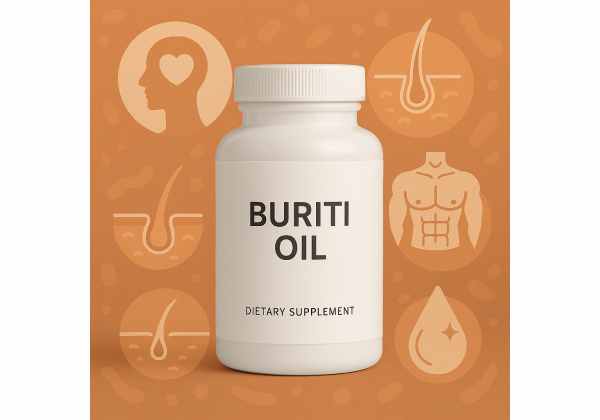Buriti oil is emerging as a coveted natural supplement for skin health, hair nourishment, and antioxidant protection. Sourced from the bright orange fruit of the Mauritia flexuosa palm native to the Amazon, buriti oil is treasured for its exceptionally high beta-carotene, vitamin E, and essential fatty acid content. This rich, reddish-gold oil is used topically and internally for hydrating the skin, soothing inflammation, supporting eye health, and enhancing radiance from within. Its unique profile has made it a staple in both traditional wellness practices and modern natural beauty routines. In this guide, you’ll discover the science-backed benefits, uses, optimal dosing, and potential side effects of buriti oil.
Key Takeaways
- Rich in Nutrients: Buriti oil boasts some of the highest natural levels of beta-carotene and vitamin E, supporting skin repair, antioxidant defense, and eye health.
- Multi-Purpose Beauty Oil: Popular in hair and skin care, it hydrates, soothes, and protects while promoting a healthy glow.
- Traditional and Modern Uses: Used for generations in Amazonian communities and now featured in premium natural supplements and cosmetics.
- Generally Safe: Well-tolerated for most people when used as directed, but possible allergic reactions or sensitivities can occur.
- Versatile Administration: Can be applied topically, taken internally (with care), or blended with other oils for customized routines.
Table of Contents
- Buriti Oil Overview: What Is It and How Does It Work?
- The Science of Buriti Oil: Understanding Its Bioactive Compounds
- Evidence-Backed Benefits of Buriti Oil for Health and Beauty
- Buriti Oil Safety, Side Effects, and Drug Interactions
- How to Use Buriti Oil: Dosage, Application, and Best Practices
- Frequently Asked Questions About Buriti Oil
Buriti Oil Overview: What Is It and How Does It Work?
Buriti oil is an exotic, nutrient-dense oil extracted from the fruit of the buriti palm (Mauritia flexuosa), a towering tree that thrives along riverbanks in the Amazon rainforest. Sometimes called the “tree of life” by indigenous Amazonian communities, the buriti palm has played a central role in local diets, medicine, and culture for centuries.
The oil itself is cold-pressed from the flesh of the fruit, yielding a deeply orange-red liquid. This vibrant color is a visual cue to its extraordinary concentration of beta-carotene—often reported as the highest among all fruits and oils, even surpassing carrot oil. Alongside beta-carotene, buriti oil is abundant in tocopherols (vitamin E), vitamin A precursors, and essential fatty acids such as oleic acid and palmitic acid.
What Sets Buriti Oil Apart?
- Unmatched Beta-Carotene Content: This antioxidant pigment gives buriti oil its signature color and provides the body with a precursor to vitamin A, supporting vision, skin renewal, and immune health.
- Exceptional Vitamin E Levels: Vitamin E, a well-known antioxidant, supports cell membrane integrity, soothes inflammation, and protects against oxidative stress.
- Rich in Healthy Fats: Its high oleic acid content (a type of omega-9 fatty acid) promotes skin hydration, barrier repair, and overall cardiovascular wellness.
Traditional and Modern Uses
For generations, Amazonian peoples have used buriti oil for culinary, medicinal, and cosmetic purposes:
- Skin and Wound Care: Applied to soothe burns, heal cuts, and reduce irritation.
- Sun Protection: Used as a natural sun filter and after-sun soother, thanks to its ability to absorb UV rays and calm redness.
- Dietary Supplement: Eaten fresh or added to traditional dishes for nutritional fortification.
Today, buriti oil is increasingly found in premium natural skincare and haircare products, valued for its emollient properties and ability to enhance radiance and elasticity. Some advanced dietary supplements also include buriti oil for its carotenoid and antioxidant content.
How Buriti Oil Is Processed
- Harvesting: Ripe buriti fruits are collected, typically during the dry season.
- Extraction: The fruit pulp is separated, then cold-pressed or mechanically extracted to retain heat-sensitive nutrients.
- Minimal Refinement: High-quality buriti oil is minimally processed to preserve its natural antioxidants and beneficial compounds.
Color, Aroma, and Stability
- Color: Deep golden-orange to reddish hues, depending on the extraction process.
- Aroma: Mild, earthy, and slightly nutty—never overpowering or unpleasant.
- Shelf Life: Naturally stable due to its antioxidant content but should be stored away from heat and sunlight.
Buriti Oil in Natural Wellness Trends
Interest in buriti oil is rapidly expanding among wellness enthusiasts, dermatologists, and cosmetic formulators. Its ability to hydrate, soothe, and protect skin—while also acting as an internal source of potent antioxidants—sets it apart from many conventional oils.
The Science of Buriti Oil: Understanding Its Bioactive Compounds
At the heart of buriti oil’s impressive benefits lies a synergistic blend of bioactive nutrients rarely matched by other plant oils. Let’s explore how each component works and why they matter for human health.
1. Beta-Carotene: The King of Carotenoids
Buriti oil is often celebrated as the richest known natural source of beta-carotene—a carotenoid pigment responsible for the oil’s brilliant red-orange color. Beta-carotene is a precursor to vitamin A, essential for vision, skin health, immune function, and cellular growth.
- How It Works: Once ingested or absorbed through the skin, beta-carotene is converted by the body into retinol (active vitamin A) as needed. This conversion is tightly regulated, minimizing the risk of vitamin A toxicity.
- Antioxidant Role: Beta-carotene helps neutralize free radicals—unstable molecules that can damage cells and accelerate aging. This antioxidant effect supports skin resilience, eye health, and immune defense.
- Photoprotection: Studies suggest beta-carotene may help protect the skin from UV damage by absorbing harmful light and quenching oxidative stress in skin tissues.
2. Vitamin E (Tocopherols): Cellular Defender
Vitamin E is another standout in buriti oil’s nutrient arsenal. This fat-soluble vitamin is widely recognized for its ability to stabilize cell membranes and prevent oxidative damage:
- Cell Protection: Tocopherols shield cell membranes from damage caused by environmental stressors, including pollution and sunlight.
- Anti-Inflammatory Effects: Vitamin E may help calm redness, soothe irritation, and accelerate the healing of minor wounds and burns.
- Synergy with Beta-Carotene: When combined, vitamin E and beta-carotene offer broad-spectrum antioxidant protection, amplifying the overall benefits of buriti oil.
3. Essential Fatty Acids: Nourishment for Skin and Beyond
Buriti oil contains a balanced profile of beneficial fatty acids:
- Oleic Acid (Omega-9): Renowned for its deep skin-penetrating and hydrating properties, making buriti oil a superb moisturizer.
- Palmitic Acid: Adds a protective layer to the skin, helping to seal in moisture and support barrier repair.
- Linoleic Acid (Omega-6): Although present in smaller amounts, this fatty acid is crucial for skin elasticity and softness.
These healthy fats contribute to buriti oil’s ability to restore suppleness, reduce flakiness, and promote a smoother, more resilient complexion.
4. Minor Compounds: The Hidden Gems
Buriti oil also contains lesser-known, bioactive compounds that support its health effects:
- Phytosterols: Plant-based sterols that may reduce inflammation and promote skin healing.
- Polyphenols: Potent antioxidants that help reduce oxidative stress and may slow signs of aging.
- Squalene: Naturally moisturizing and protective, often found in premium skincare.
Absorption and Bioavailability
- Topical Application: When applied to the skin or hair, buriti oil is quickly absorbed, delivering its antioxidants and fatty acids deep into the epidermis.
- Oral Consumption: The oil’s fat-soluble nutrients are best absorbed when taken with food containing healthy fats.
Synergistic Effects in the Body
The combination of carotenoids, vitamin E, and fatty acids in buriti oil produces effects greater than the sum of its parts:
- Enhanced Moisture Retention: Locks in hydration and restores elasticity.
- Robust Antioxidant Defense: Protects against environmental and metabolic stress.
- Supports Regeneration: Encourages skin renewal and may help reduce visible signs of sun damage or aging.
Scientific Research: What Do We Know?
Emerging studies continue to uncover the therapeutic potential of buriti oil, particularly in the realms of dermatology and nutrition:
- Skin Barrier Repair: Lab tests have shown that buriti oil can enhance recovery from dryness, irritation, and UV-induced stress.
- Oxidative Stress Reduction: Its potent antioxidant activity helps protect skin cells and tissues from free radical damage.
- Eye and Immune Health: As a leading dietary source of beta-carotene, buriti oil supports vision and immune function.
However, much of the research is still in early stages or derived from traditional use and small-scale studies. As interest grows, larger clinical trials are likely to expand our understanding of buriti oil’s benefits.
Evidence-Backed Benefits of Buriti Oil for Health and Beauty
Buriti oil’s reputation as a health and beauty powerhouse is well-deserved, thanks to its unique nutritional profile and proven efficacy in a range of applications. Here’s a deep dive into the top evidence-based benefits, supported by both traditional wisdom and modern science.
1. Potent Skin Hydration and Rejuvenation
Buriti oil is cherished in skin care for its ability to deeply moisturize and restore suppleness. Its high oleic acid content allows it to penetrate the skin easily, delivering nourishment where it’s needed most.
- Restores Dry, Flaky Skin: Regular use helps reduce rough patches, scaling, and chronic dryness, especially in harsh weather.
- Boosts Elasticity: The combination of fatty acids and antioxidants supports collagen production and skin resilience, diminishing the appearance of fine lines.
- Promotes a Radiant Glow: Buriti oil’s beta-carotene imparts a subtle, healthy radiance, reviving dull, tired-looking skin.
2. Powerful Antioxidant Protection Against Aging
The dual action of beta-carotene and vitamin E makes buriti oil a potent antioxidant supplement. This means it helps neutralize free radicals that cause premature aging, sun spots, and loss of firmness.
- Reduces Fine Lines and Wrinkles: Antioxidants support cell repair and renewal, softening visible signs of aging.
- Defends Against Sun Damage: While not a sunscreen, buriti oil may offer natural photoprotection and support recovery from UV exposure.
- Slows Environmental Aging: Helps counteract damage from pollution, smoke, and other environmental aggressors.
3. Soothes and Calms Sensitive or Irritated Skin
With its natural anti-inflammatory compounds, buriti oil can help calm redness, itching, and inflammation. This makes it an excellent choice for people with sensitive, reactive, or problematic skin.
- Relieves Eczema and Psoriasis: While not a cure, its soothing properties may help manage flare-ups and maintain moisture.
- Accelerates Healing: Used traditionally to promote recovery from minor burns, sunburns, and wounds, thanks to its regenerative effects.
- Gentle on All Skin Types: Its lightweight, non-comedogenic profile makes it suitable even for acne-prone or delicate skin.
4. Nourishes and Strengthens Hair
Buriti oil is a secret weapon for shiny, strong, and healthy hair. It helps replenish lost moisture, fortify the hair shaft, and restore shine.
- Revitalizes Dry, Damaged Hair: Regular application as a mask or leave-in treatment can repair split ends and improve texture.
- Protects Against Heat and Styling Damage: Forms a protective layer that shields hair from environmental and mechanical stress.
- Promotes Scalp Health: Its nutrients support a balanced scalp environment, potentially reducing dandruff and irritation.
5. Supports Eye and Immune Health
Because buriti oil is so high in beta-carotene—a precursor to vitamin A—it offers systemic benefits beyond just skin and hair.
- Protects Vision: Beta-carotene supports the maintenance of healthy vision and may help prevent age-related eye concerns.
- Strengthens Immunity: Adequate vitamin A intake is critical for robust immune defense and recovery from illness.
6. Other Traditional and Emerging Uses
- Digestive Health: Some traditional practices use buriti oil to soothe digestive discomfort and support gut lining health.
- Culinary Use: In some Amazonian regions, buriti oil is added to foods for its flavor and nutritional value, though this practice is less common outside South America.
7. Integrative Uses in Modern Wellness
- Blends Well With Other Oils: Can be mixed with jojoba, argan, or rosehip oil for custom skin or hair blends.
- Carrier Oil for Essential Oils: Its stability and nutrient density make it an excellent carrier for aromatherapy applications.
User Testimonials and Real-World Results
Many users report noticeable improvements in skin texture, radiance, and moisture levels after adding buriti oil to their routines. Hair stylists and dermatologists alike recommend it for restoring luster and resilience to hair and skin subjected to daily stress.
Who Can Benefit Most from Buriti Oil?
- Individuals with dry, mature, or sun-damaged skin.
- People seeking natural, plant-based solutions for aging or sensitive skin.
- Those with dry, brittle, or chemically treated hair.
- Anyone looking to boost dietary antioxidant intake with a natural supplement.
While anecdotal results are strong, more robust clinical evidence is needed to fully validate every use. However, its safety profile and long tradition of use make buriti oil a promising addition to holistic health and beauty routines.
Buriti Oil Safety, Side Effects, and Drug Interactions
As buriti oil continues to gain recognition among natural wellness advocates and consumers worldwide, understanding its safety profile is crucial for responsible use. Although generally well-tolerated and celebrated for its natural origins, any supplement—no matter how pure—can carry potential risks. Let’s break down what you need to know about buriti oil’s side effects, safety in special populations, possible interactions, and practical risk mitigation.
1. Is Buriti Oil Safe for Everyone?
For most healthy adults, both topical and dietary use of buriti oil is considered safe when used as directed. The oil’s long history in Amazonian culture for skin care, wound treatment, and nutritional supplementation speaks to its overall low toxicity.
However, certain individuals should exercise extra caution:
- Allergy-prone users: Those with known sensitivities to palm fruits, nuts, or plant oils should patch test before first topical use.
- Pregnant or breastfeeding women: While external use is likely safe, oral consumption should be discussed with a healthcare provider, as robust human safety data is limited.
- Children: Topical use on children’s skin should always begin with a small patch test. Internal use for minors is not generally recommended without medical supervision.
2. Potential Side Effects of Buriti Oil
Buriti oil side effects are rare, especially with topical application. Still, some users may experience:
- Mild skin irritation: Redness, itching, or rash, particularly in those with highly sensitive skin or allergies.
- Clogged pores (rare): While buriti oil is generally considered non-comedogenic, excessive use, particularly on oily or acne-prone skin, could potentially block pores in sensitive individuals.
- Digestive upset: When ingested in high amounts, some people might experience loose stools, stomach discomfort, or a change in stool color due to the oil’s richness and pigment content.
- Carotenemia: Excessive oral intake of buriti oil (or other beta-carotene-rich oils) may rarely cause a yellow-orange discoloration of the skin, a harmless but noticeable condition called carotenemia. This resolves with reduced intake.
3. Drug and Supplement Interactions
To date, no significant interactions between buriti oil and common prescription medications or supplements have been documented in scientific literature. Still, potential interactions to consider include:
- Vitamin A-containing supplements: Since buriti oil is rich in beta-carotene (a vitamin A precursor), avoid combining high-dose buriti oil with other vitamin A or retinol supplements, as excess vitamin A can be toxic over time.
- Blood-thinning medications: Some plant oils rich in vitamin E (like buriti oil) may theoretically enhance the effects of anticoagulants, but this is unlikely at typical topical or culinary dosages.
- Fat absorption-altering medications: Medications that inhibit fat absorption (like orlistat) could reduce the absorption of buriti oil’s fat-soluble nutrients.
Always consult your healthcare provider before adding any new supplement, especially if you take prescription drugs or have chronic medical conditions.
4. Safe Use Guidelines and Best Practices
To maximize the benefits of buriti oil while minimizing risk:
- Start with a patch test: Apply a small amount to the inner forearm and wait 24–48 hours for any adverse reaction.
- Monitor dosage: When taking internally, follow the product’s recommended serving size and avoid excessive use.
- Store properly: Keep buriti oil in a cool, dark place to preserve freshness and prevent oxidation.
- Check product quality: Choose only 100% pure, cold-pressed, and unrefined buriti oil from reputable brands to avoid contamination and degradation.
5. Contraindications and When to Avoid Use
- History of severe plant oil allergies
- Active skin infections or open wounds (for topical use)
- Unexplained skin reactions after application
6. When to Seek Medical Advice
If you experience persistent redness, swelling, burning, hives, or any unexpected symptoms after using buriti oil, discontinue use and consult a healthcare professional promptly. If taken orally and you notice nausea, vomiting, severe digestive upset, or jaundice (yellowing of the skin or eyes), seek immediate medical attention.
7. Environmental and Ethical Safety
Responsible sourcing is also part of “safety” for both the consumer and the planet. Opt for buriti oil sourced from sustainable, ethical harvesters to ensure preservation of Amazonian biodiversity and fair trade practices for indigenous communities.
Quick Recap: Key Buriti Oil Safety Tips
- Well-tolerated for most, with rare allergic or irritant reactions.
- Avoid internal overuse, especially with other vitamin A sources.
- Patch test before first use on sensitive skin.
- Check sourcing, purity, and storage for maximum safety and efficacy.
How to Use Buriti Oil: Dosage, Application, and Best Practices
Maximizing the benefits of buriti oil comes down to proper usage, smart dosing, and a few expert tips for topical and internal application. Here’s a detailed guide on how to integrate buriti oil safely and effectively into your wellness, skin, and hair care routines.
1. Topical Use: Skin and Hair Applications
A. For Skin:
- Daily Moisturizer: After cleansing, apply 2–3 drops of pure buriti oil directly to damp skin. Massage gently until fully absorbed.
- Serum Booster: Add a few drops to your favorite moisturizer, serum, or body lotion for an antioxidant boost.
- Targeted Care: Dab onto areas prone to dryness, redness, or fine lines—especially around the eyes, mouth, and neck.
- After-Sun Care: Apply to sun-exposed skin for soothing, antioxidant support.
B. For Hair:
- Pre-shampoo Mask: Massage 5–10 drops into the scalp and lengths of hair. Leave on for 15–30 minutes, then shampoo as usual.
- Leave-In Shine Serum: Use 1–2 drops warmed in the palms, smoothing lightly over the ends of damp or dry hair to reduce frizz and add shine.
- Scalp Soother: Apply sparingly to irritated or flaky scalp patches as needed.
Pro Tips:
- Less is more—buriti oil is highly concentrated. Overuse can leave a residue.
- Use on damp skin or hair for best absorption.
- Patch test first if you have sensitive or reactive skin.
2. Internal Use: Dietary Supplementation
While most common as a topical beauty oil, buriti oil can also be taken internally as a dietary supplement. However, always follow product-specific guidelines and consider the following:
- Dosage: Standard recommended intake is usually 1–2 teaspoons (approx. 5–10 mL) daily, mixed into smoothies, dressings, or taken by spoon. Never exceed the manufacturer’s instructions.
- Timing: Take with meals containing healthy fats for best absorption of fat-soluble nutrients.
- Pairing: Avoid pairing with high-dose vitamin A supplements to reduce risk of excess intake.
Note: Not all buriti oil products are labeled or processed for internal use. Only ingest oils clearly marked as food-grade or dietary supplement.
3. Combining with Other Oils
- Synergistic Blends: Buriti oil pairs well with jojoba, rosehip, argan, or squalane for customized skin and hair treatments.
- Carrier Oil: Acts as a carrier for essential oils in massage blends, enhancing delivery and absorption.
4. Storage and Shelf Life
- Keep cool and dark: Buriti oil’s nutrients degrade with heat and light; store in an amber or opaque glass bottle away from direct sunlight.
- Refrigeration: Optional but can further extend shelf life, especially in warm climates.
- Check for spoilage: Fresh buriti oil should have a mild, pleasant aroma and deep orange-red color. Rancid oil will smell off or stale.
5. Best Practices for Sensitive Populations
- Pregnant or breastfeeding: Limit to topical use unless advised otherwise by a qualified professional.
- Children: External use only, in minimal amounts, and avoid contact with eyes or mucous membranes.
- Allergy sufferers: Consult an allergist before use and always perform a patch test.
6. How to Choose High-Quality Buriti Oil
- Look for cold-pressed, unrefined varieties to retain the highest levels of beta-carotene and vitamin E.
- Check for organic and ethical sourcing—prefer oils certified organic, wild-harvested, and fair-trade.
- Read ingredient labels—avoid products with added fragrances, preservatives, or diluting carrier oils unless clearly disclosed.
7. Integrating Buriti Oil Into Your Routine
- Start slow: Introduce buriti oil into your routine gradually to monitor your skin’s and body’s response.
- Track results: Note any positive changes in skin texture, tone, or hair luster over several weeks.
- Customize: Adapt your use based on season, climate, and your unique skin or hair needs.
Frequently Asked Questions About Buriti Oil
How do you use buriti oil for skin benefits?
Apply a few drops of pure buriti oil to clean, damp skin as a moisturizer, or mix with lotions or serums. Its high beta-carotene and vitamin E content hydrate, soothe, and protect skin from environmental stress.
Is buriti oil safe for sensitive or acne-prone skin?
Yes, buriti oil is generally non-comedogenic and gentle. However, those with highly sensitive or acne-prone skin should patch test first and use only small amounts to ensure compatibility.
Can you eat or take buriti oil as a dietary supplement?
Yes, if labeled food-grade or as a dietary supplement. Take 1–2 teaspoons daily with food, but avoid high doses and consult a healthcare provider if pregnant, breastfeeding, or on medication.
What are the main side effects of buriti oil?
Buriti oil is usually well-tolerated, but rare side effects include mild skin irritation, allergic reactions, or digestive upset if taken in large amounts. Patch test and follow usage recommendations to reduce risk.
Does buriti oil help protect against sun damage?
Buriti oil contains antioxidants like beta-carotene and vitamin E, which may help protect skin from oxidative stress caused by sun exposure. However, it is not a substitute for sunscreen and should be used as a supportive after-sun treatment.
Can buriti oil be used on hair?
Absolutely. Use buriti oil as a pre-shampoo mask, leave-in serum, or scalp treatment to add moisture, shine, and strengthen hair, especially if it’s dry or damaged.
How should buriti oil be stored for maximum freshness?
Store buriti oil in a cool, dark place, preferably in an amber glass bottle. Refrigeration can further extend its shelf life, but always check for any change in aroma or color before use.
Disclaimer:
The information in this article is provided for educational and informational purposes only and is not intended as medical advice. Always consult a qualified healthcare provider before starting any new supplement or making significant changes to your health regimen, especially if you are pregnant, nursing, have a medical condition, or are taking medications.
If you found this guide helpful, please share it with friends and family on Facebook, X (formerly Twitter), or your favorite social media platform—and don’t forget to follow us for more expert tips and research updates. Your support helps us continue producing high-quality wellness content for everyone!











